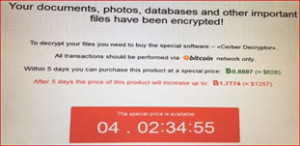 The latest virus of the ransomware family that has been unleashed upon Internet users is titled: Cerber 4.1.5
The latest virus of the ransomware family that has been unleashed upon Internet users is titled: Cerber 4.1.5
Recent studies of leading cyber-security experts have determined that the most successful distribution method for ransomware is through malvertisements. These malicious adverts may appear genuine and possibly even attractive, but the second your cursor delivers a click on the sneaky banner or pop-up – you’re done for. The virus is downloaded onto your computer and does what it does best, encrypt your files, topping it off with a ransom note, so you know by how much money you’ll be poorer.
With this version not only will the filename be scrambled, but the extension will be replaced as well. This means that a file will now be encrypted to a name like 1xQHJgozZM.b71c or 5NgPiSr5zo..abd3.
We urge readers to ignore the various suspicious ads displayed throughout the web. You can never be sure of what places they might take you to or what malicious piece of software might be hiding behind them. Banner ads are highly suspicious on their own and coupled with the high payout for cyber criminals ignore them or you might get more than you bargained for. Don’t. Click. The ads.
Ransomware, the type of malware Cerber 4.1.5 belongs to, has been around for decades now and is probably one of the oldest types of virus threats out there. It first appeared in Russia in the late 1980’s and spread throughout the country in the following several years, but it has since gained enormous popularity and distribution across the globe. It is the second most common type of virus and the exponential growth it has been experiencing over recent years sets it at the top of the cyber-security threat list. These stats are largely due to the mind boggling profits ransomware generates for the hackers behind it, with separate infamous instances reaching 8-digit figures in extorted funds.
What is Cerber 4.1.5 and How Do I Get It?
Today, pretty much anyone risks getting infected, provided they aren’t careful and don’t implement basic security measures. You can get infected via a spam email that’s carrying a Trojan Horse. Trojan horses are ransomware’s best friends and they infiltrate your system by stealth, typically when you open an attachment of such infected spam emails or click a link included in the email which takes you to a delivery website. They then proceed to download the ransomware, just as stealthily, onto your machine, where it immediately gets down to its dirty work. The chances of you detecting a piece of ransomware, while it’s in the process of encrypting your files, are slim to none.
Be extremely cautious with newly received emails, especially if those were redirected to your spam folder. Assess the details of the messages without opening them if they seem suspicious or dangerous -simply delete them. Remember that hackers aren’t stupid and they will use elaborate techniques in the hopes that you’ll lower you guard.
It’s also possible for ransomware and other viruses to sink their claws in your system through infected torrent files or shareware. We recommend abstaining from visiting untrustworthy, questionable sites altogether. However, simply minding your surfing destinations isn’t enough. It’s vital that you also have a reliable antivirus program installed on your computer and to be extra safe – a good anti-malware tool won’t set you back by much, but it will certainly be worth every invested penny.
Nevertheless, it’s good to know that the encryption process could take up an obscene amount of your PC’s resources, which could potentially make it run very slow. Should this be the case and you have reason to suspect an intruder is present, check the Task Manager for the processes using the most RAM/CPU. Notice something unfamiliar? Shut down your computer and call in a specialist.
It should also be noted that there is no known decryption method currently available except to restore files from a good backup. If you don't have a reliable backup system call in a specialist to get one set up for you. Don't wait until you get hit with ransomware to take action. It will be too late then to recover your files.

 Contact Us At
Contact Us At

